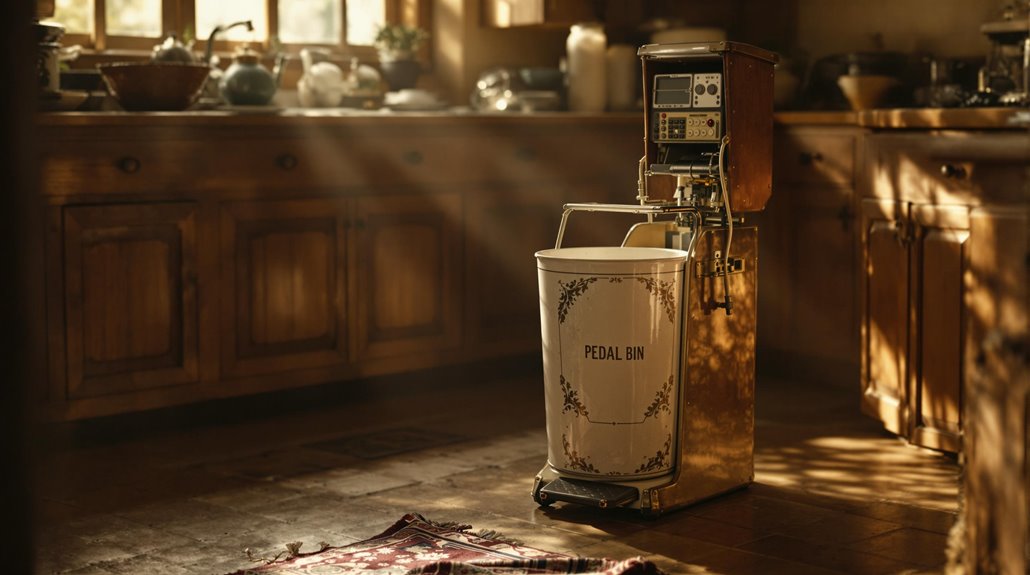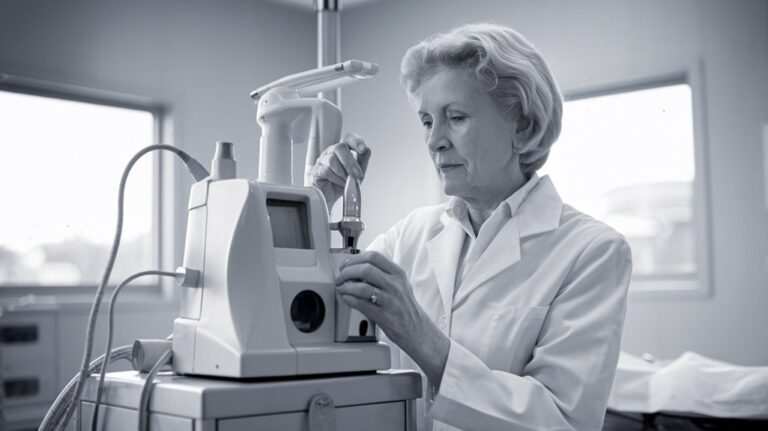Lillian Gilbreth’s Foot Pedal Bin: A Mad Dash to Toss Out Old Trash Cans
You've probably kicked open a step-on trash bin without giving it a second thought, but this simple action represents one of the most practical kitchen innovations of the 20th century. When Lillian Gilbreth introduced the foot pedal bin, she wasn't just solving a minor inconvenience – she was tackling serious hygiene concerns that plagued households of her era. Her elegant solution would go on to influence far more than just waste disposal.
The Brilliant Mind Behind the Bin: Meeting Lillian Gilbreth

While many know Lillian Gilbreth for her foot pedal bin invention, her brilliance extended far beyond household innovations. Born into a wealthy German American family in Oakland, her upbringing set the stage for an extraordinary life of achievement.
You'll find Lillian's pioneering spirit reflected in her impressive academic journey – from earning degrees at UC Berkeley to becoming the first mother to receive a doctorate from Brown University. She didn't just break barriers; she shattered them. Her dedication to education led her to champion the industrial engineering curriculum at numerous schools.
As the first female engineering professor at Purdue and the first woman elected to the National Academy of Engineering, she transformed workplace efficiency alongside her husband Frank. Together, they raised 12 children while revolutionizing industrial psychology and management practices, proving that brilliance knows no bounds. Her commitment to innovation earned her the prestigious Hoover Medal in 1966, marking another historic achievement in her remarkable career.
A Step Ahead: The Birth of the Foot Pedal Innovation
When Lillian Gilbreth turned her analytical mind to kitchen efficiency in the early 1900s, she spotted a clear problem: traditional trash cans required unnecessary hand contact and wasted movements.
Drawing from her industrial engineering expertise, she envisioned a solution that would revolutionize kitchen waste disposal.
The answer lay in pedal mechanics – a simple yet ingenious foot-operated system that would lift the lid without requiring hand contact.
This innovation aligned perfectly with her commitment to reducing household drudgery through practical solutions.
You'll recognize this innovation as the foundation of modern step-on bins.
As a consulting engineer, Gilbreth continued to champion efficient household tools throughout her career.
Hands-Off Revolution: How the Pedal Bin Changed Kitchen Hygiene
As Gilbreth's foot pedal bin made its way into homes across America, it sparked a quiet revolution in kitchen hygiene.
You'd no longer need to touch germ-laden lids with your hands while preparing food or cleaning up. This hands-free disposal innovation aligned perfectly with the growing public health awareness of the 1920s and 30s. The introduction of galvanized metal construction made these early bins exceptionally durable.
The impact on hygiene standards was immediate and far-reaching. Modern versions continue to feature removable inner bins for easy maintenance and cleaning.
You could now prevent cross-contamination in your kitchen, as the pedal bin's design eliminated direct contact with waste receptacles. This was particularly valuable in medical settings and food preparation areas, where maintaining cleanliness was vital.
The simple yet effective mechanism reduced the spread of bacteria and germs, making your kitchen a safer, more sanitary space for food preparation and daily activities.
Beyond the Bin: Gilbreth's Kitchen Design Legacy
Though Lillian Gilbreth's foot pedal bin revolutionized kitchen hygiene, her broader impact on kitchen design transformed how we interact with our cooking spaces today.
You'll find her influence in the kitchen work triangle that connects your stove, sink, and refrigerator—a design principle that's still going strong a century later. Her Heart Kitchen project focused on making spaces accessible for homemakers with disabilities and heart conditions. Her collaboration with General Electric helped bring these innovations to households across America.
Gilbreth's obsession with kitchen ergonomics led to innovations you probably use daily, from your refrigerator's door shelves to adjustable-height countertops.
Her time-motion studies dramatically reduced the steps needed for meal preparation, while her L-shaped layouts and mobile kitchen carts maximized efficiency.
When you reach for eggs in that specially designed keeper or grab butter from its dedicated tray, you're experiencing Gilbreth's legacy of thoughtful design principles that continue shaping modern kitchens.
From Patent to Present: Evolution of the Modern Pedal Bin

Lillian Gilbreth's 1934 patent for the foot-pedal trash can marked the beginning of a remarkable evolution in kitchen waste management.
The initial galvanized metal design has transformed into today's modern design marvels, featuring materials like stainless steel, bamboo, and innovative plastics. Modern pedal bins like the SONO offer removable inner buckets for easy waste disposal and cleaning. Products like the New Icon series from Brabantia showcase this evolution with sizes ranging from 3L to 30L.
You'll find these key developments in waste management technology:
- Soft-close mechanisms that prevent noisy lid slamming
- Touchless sensors and voice activation for hands-free operation
- Odor control features for a better kitchen environment
- Multi-compartment options for recycling and waste sorting
Today's pedal bins aren't just functional—they're stylish additions to your home.
From the 1950s' colorful plastic versions to contemporary SONO designs with soft-touch materials, you'll see how far we've come from Gilbreth's original invention, while maintaining her core principle of hands-free operation.
The Lasting Impact on Home Efficiency and Ergonomics
While revolutionizing kitchen waste management, the foot-pedal bin's impact extended far beyond its primary function, fundamentally transforming home efficiency and ergonomics.
You'll find its influence woven throughout modern home organization, from the way you arrange your kitchen workspace to how you interact with household appliances. Drawing from her work with time and motion, Gilbreth's systematic approach helped eliminate wasted movements in household tasks.
The ergonomic benefits of Gilbreth's design changed how designers approach household items, establishing principles that prioritize user comfort and accessibility.
The foot-operated mechanism didn't just make waste disposal easier – it sparked a movement toward hands-free solutions that enhance multitasking and improve hygiene.











